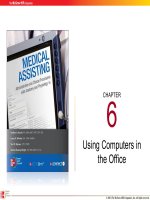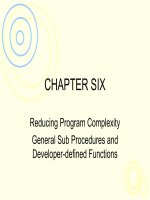Lecture Clinical procedures for medical assisting (4/e): Chapter 6 – Booth, Whicker, Wyman
Bạn đang xem bản rút gọn của tài liệu. Xem và tải ngay bản đầy đủ của tài liệu tại đây (1.43 MB, 54 trang )
CHAPTER
6
Obtaining Vital
Signs and
Measurements
© 2011 The McGraw-Hill Companies, Inc. All rights reserved.
62
Learning Outcomes
6.1 Describe vital signs and common body
measurements.
6.2 Differentiate measurement systems.
6.3 Identify the instruments used to measure vital
signs and body measurements.
6.4 Carry out vital signs and body measurements
of infants, children, and adults.
© 2011 The McGraw-Hill Companies, Inc. All rights reserved.
63
Learning Outcomes (cont.)
6.5 Recognize abnormal vital signs and body
measurements.
6.6 Write vital signs and body measurements
using accurate terminology and
abbreviations.
6.7 Implement growth charts.
© 2011 The McGraw-Hill Companies, Inc. All rights reserved.
64
Introduction
• Vital signs
– Temperature
– Pulse
– Respirations
– Blood pressure
– Pain assessment
• Body
measurements
– Height
– Weight
– Head
circumference
Vital signs and body measurements are used
to evaluate health problems.
Accuracy is essential.
© 2011 The McGraw-Hill Companies, Inc. All rights reserved.
65
Vital Signs
• Provide information about patient’s overall
condition
• Taken at each visit and compared to
baseline
• Protected health information – HIPAA
© 2011 The McGraw-Hill Companies, Inc. All rights reserved.
66
Temperature
• Febrile – body temperature above
patient’s normal range
– Fever – sign of inflammation or infection
– Hyperpyrexia – extremely high temperature
• Afebrile – normal body temperature
© 2011 The McGraw-Hill Companies, Inc. All rights reserved.
67
Temperature (cont.)
• Measurements
Ear
Mouth
Temperature
Routes
Axilla
Rectal
Temporal
Artery
– Degrees Fahrenheit
(°F)
– Degrees Celsius
(centigrade; °C)
• Normal adult oral
temperature
– 98.6°F
– 37°C
© 2011 The McGraw-Hill Companies, Inc. All rights reserved.
68
Thermometers
• Electronic digital
thermometer
– Accurate, fast, easy to read
– Comfortable for the patient
• Tympanic thermometer
• Temporal scanner
• Disposable thermometer
– Single use
– Less accurate
Disposable sheaths are used with electronic thermometers
to prevent cross-contamination.
© 2011 The McGraw-Hill Companies, Inc. All rights reserved.
69
Taking Temperatures
• Measure to nearest tenth
of a degree
• Oral temperatures
– Wait at least 15
minutes after eating,
drinking, or smoking
– Place under tongue in
either pocket just offcenter in lower jaw
© 2011 The McGraw-Hill Companies, Inc. All rights reserved.
610
Taking Temperatures (cont.)
• Tympanic temperatures
– Proper technique essential
– Adult – pull ear up and
back
– Child – pull ear down and
back
– Fast, easy to use, and
preferred in pediatric
offices
© 2011 The McGraw-Hill Companies, Inc. All rights reserved.
611
Taking Temperatures (cont.)
• Rectal temperatures
– Use Standard Precautions – gloves
– Patient is positioned on side (left side preferred) or
stomach
– Lubricate tip of thermometer
– Slowly and gently insert tip into anus
• ½ inch for infants
• 1 inch for adults
– Hold thermometer in place while temperature is taken
© 2011 The McGraw-Hill Companies, Inc. All rights reserved.
612
Taking Temperatures (cont.)
• Axillary
temperatures
– Place patient in seated
or lying position
– Place tip of
thermometer in middle
of axilla with shaft
facing forward
– Probe must touch skin
on all sides
• Temporal
temperatures
– Temporal scanner
– Noninvasive, quick
– Stroke scanner across
forehead, crossing
over the temporal
artery
© 2011 The McGraw-Hill Companies, Inc. All rights reserved.
613
Taking Temperatures (cont.)
• Children
– Take temperature last
if child cries or
becomes agitated
– Agitation will cause
pulse, respiration, and
blood pressure to
elevate
– Oral route is not
appropriate for
children under 5 years
old
© 2011 The McGraw-Hill Companies, Inc. All rights reserved.
614
Pulse and Respiration
Circulatory
Pulse
Respiratory
Respirations
Pulse and respirations are related because the heart and
lungs work together. Normally, an increase or decrease in
one causes the same effect on the other.
© 2011 The McGraw-Hill Companies, Inc. All rights reserved.
615
Pulse
• Pulse – number of times the heart beats in
1 minute
• Respiration – number of times a patient
breathes in 1 minute
– One breath = one inhalation and one
exhalation
• Ratio of pulse to respirations is 4:1
© 2011 The McGraw-Hill Companies, Inc. All rights reserved.
616
Pulse (cont.)
• Indirect measurement
of cardiac output
• Problems if
–
–
–
–
Tachycardia
Bradycardia
Weak
Irregular
• Sites of
measurement
– Adults – radial artery
– Children – brachial
artery (antecubital
space)
– Apex of heart
• 5th intercostal space
directly below center of
left clavicle
• Apical pulse taken with
a stethoscope
© 2011 The McGraw-Hill Companies, Inc. All rights reserved.
617
Pulse (cont.)
• Locate pulse by pressing
lightly with index and
middle finger pads at the
pulse site
• Count the number of beats
felt in 1 minute
• If regular – may count
beats for 30 seconds and
multiply by 2
© 2011 The McGraw-Hill Companies, Inc. All rights reserved.
618
Pulse (cont.)
Regular Pulse Rhythm
Irregular Pulse Rhythm
Count for 30 seconds,
Count for one full minute
then multiply by 2 (a rate of
35 beats in 30 seconds
equals a pulse rate of 70
beats/minute)
May use stethoscope to
listen for apical pulse and
count for a full minute
Click for sounds
© 2011 The McGraw-Hill Companies, Inc. All rights reserved.
619
Pulse (cont.)
• Electronic
measurement devices
– Blood pressure
machine
– Pulse oximetry unit
• Infrared light measures
pulse and oxygen
levels
• Report oxygen level
below 92% not
improved by deep
breathing
© 2011 The McGraw-Hill Companies, Inc. All rights reserved.
620
Respiration
• Respiratory rate – indication of how well the
body provides oxygen to the tissues
• Check by watching, listening, or feeling
movement
© 2011 The McGraw-Hill Companies, Inc. All rights reserved.
621
Normal Respiratory Rates
(26-40)
(20-30)
(18-24)
(16-24)
(12-24)
(12-20)
NOTE: Ranges reflect breaths per minute
© 2011 The McGraw-Hill Companies, Inc. All rights reserved.
622
Respiration (cont.)
• Check respirations
– Look, listen, and feel
for movement of air
– Count with a
stethoscope
• Count for one full
minute
– Rate
– Rhythm – regular
– Effort (quality) –
normal, shallow, or
deep
NOTE: If patients are aware that you are counting
respirations, they may unintentionally alter their
breathing.
© 2011 The McGraw-Hill Companies, Inc. All rights reserved.
623
Respiration Irregularities (cont.)
• Indication of possible disease
• Hyperventilation – excessive rate and
depth
• Dyspnea – difficult or painful breathing
• Tachypnea – rapid breathing
• Hyperpnea – abnormally rapid or deep
breathing
© 2011 The McGraw-Hill Companies, Inc. All rights reserved.
624
Respiration Irregularities (cont.)
• Rales (noisy)
– Constriction or blockage of bronchial passages
– Pneumonia, bronchitis, asthma, or other pulmonary
disease
• Cheyne-Stokes respirations
– Periods of increasing and decreasing depth of
respiration between periods of apnea
– Strokes, head injuries, brain tumors, congestive heart
failure
• Apnea – absence of breathing
© 2011 The McGraw-Hill Companies, Inc. All rights reserved.
625
Blood Pressure
• The force at which blood is pumped
against the walls of the arteries (mmHg)
• Two pressure measurements
– Systolic pressure – measure of pressure
when left ventricle contracts
– Diastolic pressure
• Measure of pressure when heart relaxes
• Minimum pressure exerted against the artery walls
at all times
© 2011 The McGraw-Hill Companies, Inc. All rights reserved.









